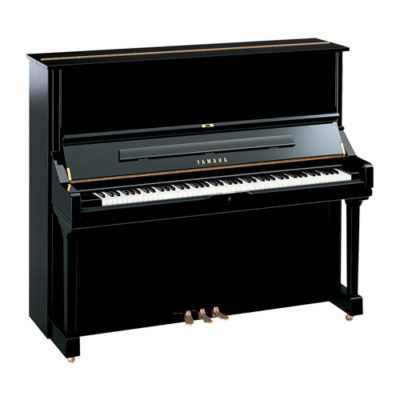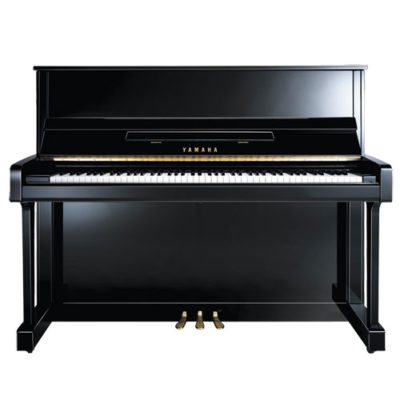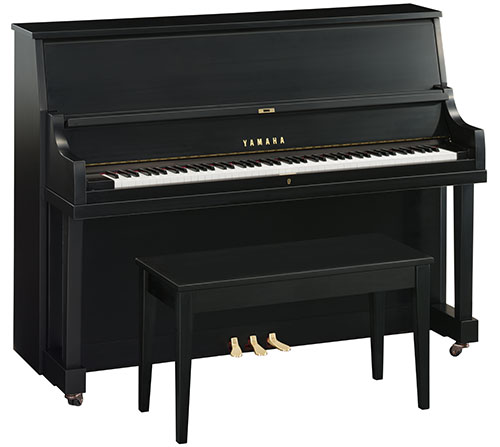Old vs New U1 and U3
Yamaha U1 and U3 designs pre-2002 are inferior to current models despite the misleading and inaccurate web-articles, forum posts and piano shop spiel.
It may still be called the Yamaha U1 or the U3, but apart from the model name, the design of the piano back, frame, scaling and action components used in the current models are quite different to those found in older models.
In fact… Yamaha’s recent additions to their upright piano range at competitive prices actually have far more in common to the current U1 design than earlier U1’s… so the ranted down Yamaha B3E is actually heavily based on the new Yamaha U1 benefitting hugely from Yamaha’s upgrades, while the P22 brings the professional standard performance of the Yamaha U1 to the domestic market at a favorable price and in a more elegant cabinet.

Yamaha U3
Functionality
Firstly, on the new U1 and U3 the fall, (the keyboard lid) now has a ‘soft close’ feature to help prevent accidental injury or damage. The music desk is now extra wide (35 inches rather than 25 inches) to provide extra room for your sheet music.
The construction
Take a look at the backposts. Most older models had 4, the new model, 5. Backposts improve rigidity, resonance and structural stability. Additionally, the new model has tone collector bolts, connecting the backpost to the iron frame to further increase stability and tonal quality.

Yamaha U1 Upright Piano
Rib configuration
The newly designed rib configurations also add strength to the soundboard yet still improve the tone.
The iron frame and scale design
The new model has a ‘perimeter’ type iron frame and redesigned bass bridge, to allow longer bass strings than in the older model and improve the depth and purity of the bass.

Yamaha B3E Upright Piano
Hammer heads and hammer felt
The new U1 has underfelted hammers and of a different shape to provide optimum tone production, response and long term durability.
Tuning pins
Lathe cut and, on the new model, nickel plated rather than the cheaper blued steel variety found on earlier versions.

Yamaha P22 upright piano
Floating Soundboard (U3)
New U3 (post yr 2002) has a ‘floating attachment’ method of soundboard fitting, allowing the soundboard to vibrate more freely, improving the depth and character of the bass and mid-range tones.
Additional Models at various price points
There are two less expensive Yamaha models which are based on the new U1 specification, using the same five backposts, tone collector bolts, rib configuration, perimeter iron frame, bass and treble strings, underfelted hammer heads and lathe cut, nickel plated tuning pins and spruce keyboard – the Yamaha P22 which has a Strunz German soundboard, and the new B3E (November 2013 onwards) has a solid spruce soundboard (pre Nov 2013 B3 had a 3 ply laminated soundboard). Both great value for money, the B3 is similarly priced to a 35 year old U1, but looks better, sounds better, plays better and will last you around 35 years longer than the old piano!
Refurbished / restored / reconditioned???
There is a misconception that most of the second hand U1 and U3s have been ‘restored.’ Restored can be interpreted in many ways, in this instance, most restoration is cosmetic, such as casework, keytops and buffing the brasswork. The following components have not usually been replaced:
- Strings – life expectancy 40-50 years max. (The bass on early Yamaha pianos was not their strong point.) Most makes of concert grands have their top treble strings replaced approximately after 10 years!
- Hammer felt – the existing felt is ‘refaced’ – ie sandpapered smooth to remove the grooves, so it looks new, but is in fact as old as the piano.
- Damper felt – again, usually this felt is not replaced.
- Soundboard, ribs and bridges – not replaced.
- Tuning pins – not replaced.
- Springs – spiral, damper and hammer butt not replaced.
The only components likely to have been replaced are the loop cords on the hammer butt (original material used would perish after approx. 20yrs – but Yamaha changed the material and maybe the key bushing cloth.
The fact that these old pianos still command such high prices with hardly any component being replaced is indeed testimony to Yamaha’s legendary design, build and component quality.
